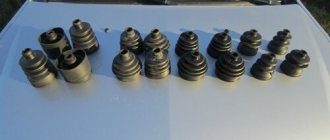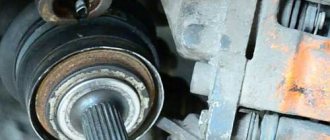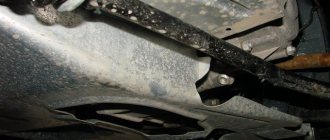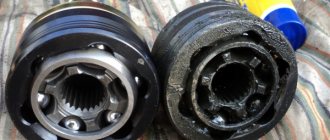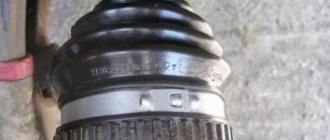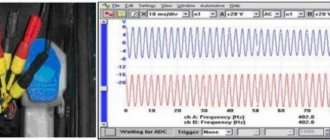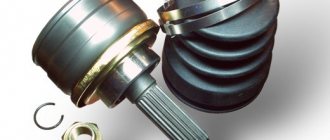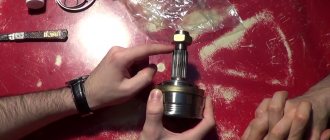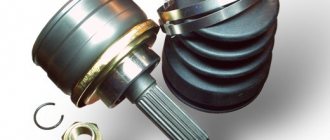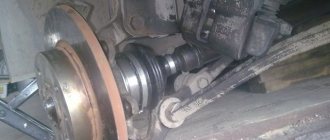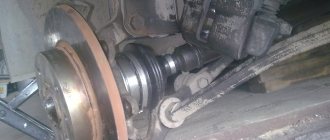Hello everyone, today we’ll talk about CV joints. In this article I will tell you how to identify a problematic CV joint, as well as how to replace the CV joint boot on a Kalina at home.
I once already talked about how to replace the CV joint on a VAZ 2108. Today everything will be almost the same, only this time we will not change the CV joint, but only the boot, and not on the V8, but on the Kalina.
A few words about what a CV joint is. This abbreviation hides four words - constant velocity joint; people usually call it a “grenade” because of its external similarity. This clever mechanism is necessary in order to ensure the transmission of torque from the gearbox to the wheels. The CV joint design allows the wheels to rotate at different angles, up to 70°.
The “grenade” mechanism is carefully hidden under the boot, inside of which there is lubricant. After several years of operation, the rubber boot of the CV joint becomes unusable, cracks form on its surface, through which the lubricant leaks out, and instead of it, dirt and moisture get inside. If damage to the boot is not detected in time, you can “ruin” the constant velocity joint itself, which is very “afraid” of sand, dirt and water that gets on its rotating parts. Therefore, it is cheaper to replace the CV joint boot than to hold out until costly repairs are required.
Replacing the outer and inner CV joints of Lada Kalina: photo, video
CV joint (constant velocity joint - approx.) or popularly just a “grenade”, is designed to transmit torque to the wheels of a car. CV joints can be internal or external, and the devices themselves are quite simple in technical terms and consist of a ball bearing that rotates transversely to its axis.
In the video, replacing CV joints on a Lada Kalina:
Failure of the CV joint on the Lada Kalina is a very common occurrence, and the main reason for its failure is torn anthers. Because, together with dust and water falling under them, the lubricant turns into thick mud, and it is no longer able to fully perform its functions.
Replacing the outer CV joint
In the process of replacing the outer CV joint
The work of replacing an outer or inner CV joint is not very difficult and can be done by any motorist who has at least once repaired a car with his own hands. And in order for the repair to be easier and faster, you need to prepare the following tools:
- Socket heads for “17” and “30”.
- Driver or ratchet.
- Extension for the wrench.
- Jack.
- Wheel chocks.
- Hammer.
- Vise.
Step-by-step disassembly procedure
After you are convinced of the malfunction of one or another CV joint, you can begin to work.
- First of all, we tear off the mounting bolts from the wheel and the hub nut, then we set the wheel chocks under the rear wheels. (To make it easier to tear off the nuts, it is better to use an extension for the wrench - approx.).
- We put the car on a jack and hang the wheel.
- We remove the wheel and, for greater reliability, place it under the car next to the jack.
- Now that this picture appears before you, all that remains is to unscrew the 2 bolts that secure the ball joint to the steering knuckle.
Unscrew the bolts marked with a red marker on both sides. - When unscrewing the ball joint, apply force and use a wrench extension.
- Turn the steering wheel as far as possible to the side and slightly pull the steering knuckle with the stand and remove the outer part of the hub along with the CV joint (For convenience, you can make several gentle blows with a hammer - approx.).
Dismantled CV joint - The next step is to dismantle the old boot and clamps. You shouldn't use them again; it's better to take a set of new ones.
- Next, you need to remove the CV joint itself.
If you have a special removable device, then use it. If not, then you will have to knock it out of place with a hammer. Without causing strong blows, the CV joint will move out of place - Hit the CV joint with a hammer, rotating it along the axle shaft. After some effort, the CV joint should give way.
If the internal CV joint is supposed to be replaced, then work 1 to 6 should be performed as well, after which, using a pry bar, we remove it from the gearbox and take out the entire assembly.
We take the inner CV joint assembled with the axle shaft to a vice where we clamp it and dismantle it.
- After the “bare” axle shaft appeared before us, the work on removing the CV joint can be considered completed.
Step-by-step assembly procedure
Work on assembling all parts should be carried out in the same order as removal, however, there are some nuances in these works.
- First of all, we put the new boot on the axle shaft; this may cause some difficulties. To make the task easier, the axle shaft can be coated with lubricant.
- Then add lubricant to the CV joint.
New lubricant added to CV joint - And the remains are in the dustbin.
- Now you need to use a hammer and a block to install the grenade on the axle shaft, using gentle blows we mount it in place.
- After it is fixed, we remove the air from the boot and secure it with clamps.
- Next, when everything is installed, all that remains is to put on the steering knuckle, fix the new hub nut and put on the wheel.
- Tighten all the nuts and lower the car from the jack.
All work on changing the CV joint, if the work is carried out correctly, will not take more than 1.5-2 hours. You can check the quality of the work performed immediately after the repair. If you start driving with the wheels turned to the side and there is no crackling, squeaking or noise, it means that the repair was carried out correctly and the car can be safely operated further.
Signs of CV joint failure
The first signs of a faulty grenade are crunching sounds in the area of the front wheel on turned out wheels when starting to move. When the fault is severe, noise appears at less significant loads.
The anther begins to “repair”
Selection of CV joints
CV joint in original packaging. Usually inside the package is a pomegranate produced by VIS
There is no consensus among car owners regarding the choice of one or another brand of constant velocity joint, but clear leaders stand out:
- VIS.
- GNK. Original packaging of GNK CV joint
Inside the GNK CV joint package - boot, CV joint, clampsGNK outer CV joint installed
- GLO.
carfrance.ru
Front suspension CV joint design
The Lada Kalina car has front-wheel drive, which receives torque using a gearbox regardless of the angle of rotation. Front suspension drives (left and right) - consist of two working joints of equal angular velocities and a connecting shaft that provides connection between them. The left short shaft is made of a special steel bar, and the right long shaft is made of durable steel pipe. The shank of the inner joint housing is connected via a spline to the differential side gear. Torque is transmitted from the hinge to the drive shaft at the required angles. A feature of the design of the internal CV joint of the Lada Kalina is that, in addition to transmitting torque at several angles, it allows movement along the axis of the hinge body and the drive shaft of the suspension when moving.
With proper operation and timely maintenance of the vehicle, the joints can last up to 100 thousand km. According to statistics, external hinges are prone to failure more often than internal ones, which is primarily due to external factors.
Replacing the viburnum CV joint. Replacing the CV joint boot on a Lada Kalina
HomeMiscellaneousReplacing CV joints Kalina
What is CV joint
The abbreviation CV joint stands for constant velocity joint, which ensures the transmission of torque from the gearbox to the wheels. People call the CV joint a grenade because of its purely visual similarity.
Thanks to its design, the CV joint allows the wheels to rotate at different angles up to 70 degrees. The CV joint itself is protected by a boot. If the machine is used for a long time, for example, several years, the rubber boot of the CV joint becomes unusable, tears and cracks appear, the lubricant gradually leaks out and mixes with dirt.
For those who are going to replace the CV joint boot for the first time, I advise you to watch this video:
How to determine that the CV joint boot needs to be replaced?
The method is simple: you need to go to the pit and inspect the boot; if it is dry and no traces of oil are visible, then everything is in order and replacement is not required yet.
If, after checking, you find that there is a malfunction and a replacement is needed, then you will need the following tool: 1. Jack, hammer, wooden block;2. Keys at 17 and 30;3. Mount, balloon;4. Flat-head screwdriver, special pliers for installing clamps;5. New boot + CV joint grease, graphite grease, kerosene or similar flushing fluid.
There is a situation when, during a sharp start, a single knock or crunch is heard in the area of the front wheels. Most likely, you are already too late and will have to change the CV joint itself.
How to replace the CV joint boot on a Lada Kalina
In order to simplify the replacement of the CV joint boot, it is better to carry out the work on the removed axle shaft.
Tighten the handbrake and put chocks under the rear wheels
It is very important that the machine is parked on a level surface. We take the balloon and start removing the wheel.
Don't rush to jack up the car; remove the bolts while the car is standing on four wheels.
After this, you can jack up one side on which the work will be done. It is dangerous to work on a jack, so be on the safe side and place a block or metal jack under the car. If there are wheel arch liners, use a screwdriver to pry up the protective cap and remove them. We place a container under the drain hole of the gearbox, unscrew the plug and drain the transmission oil. Now we unscrew the fastening bolts, thanks to which the ball is attached to the steering knuckle - there are two of them. Unscrew the hub nut. To do this, you need to fix the hub; to do this, just press the brake pedal. Here you need to ask someone to press the brake pedal.
We need to get the thrust washer, this is not difficult to do, after which we turn the wheels to the extreme position (this depends on which side the replacement is happening from) and carefully squeeze the outer CV joint out of the hub. To prevent the drive shaft from falling, it is better to hang it with a piece of wire.
8. Using a pry bar, with one hand we press the inner CV joint out of the box, and with the other hand we hold the drive shaft itself.
Important note! If you need to remove both drive shafts, you should insert the old CV joint into the box before pressing the second shaft in its place. If you do not do this, the alignment of the side gears will be disrupted, after which you will not be able to install the drive shaft.
- Now comes the most painstaking work where we will need a vice. We take the drive shaft and fix it in a vice. Using a screwdriver, remove the old clamps and cut off the old anthers if they are damaged. If they are still suitable for use, there is no need to cut them.
- Next, using a hammer and a soft metal or wood socket, knock the outer and inner CV joints off the drive shaft.
We wash the “grenade” with gasoline or kerosene as a washing liquid and check the condition of its parts. If during inspection you do not find any cracks, play or imbalance, then we will begin installing new boots on the shaft. - We put on the boots carefully so as not to tear them, then we fill the outer CV joint housing with special lubricant, after which we install its drive shaft. Then we stuff the hinge until it clicks.
- Next, using pliers, squeeze the clamp on the boot on one side. We slightly compress the boot to release the air, after which we tighten the boot clamp on the other side. 14. Now we replace the retaining ring of the inner CV joint and lubricate its splines with graphite grease, after which we carefully install the hinge into the gearbox housing.
- We fix the shaft in the side gear; to do this, take a wooden block, place it on the drive shaft and hit the block with a hammer along the axis of the drive shaft. Further assembly is performed in the reverse order.
Basic information about LADA Kalina
LADA Kalina has been produced since 2004; production of the popular second-generation car began in 2013. Kalina-1 is available in three body types: hatchback (model 1119), sedan (model 1118), station wagon (model 1117). There are cars available with petrol engines of three modifications: a 1.4-liter 16-valve engine with a power of 89 hp. s., 1.6-liter 8-valve engine producing 81 hp. s., 1.6-liter 16-valve engine producing 98 hp. With. The LADA Kalina-1 has only a manual transmission with five gears. The front axle has a classic MacPherson suspension, the rear axle has a beam with stabilizer, springs, and shock absorbers.
Typical faults of LADA Kalina-1
Significant malfunctions with Kalina rarely occur, but there are a lot of various undesirable trifles. The car’s clutch is not very reliable and has an impressive service life, regardless of the type of engine, so it can malfunction after 40-50 thousand kilometers. The main source of malfunction is a broken clutch disc.
You need to constantly monitor the oil level in the engine - sometimes it leaks through the gaskets or burns through the piston rings. On the instrument panel there is only an oil pressure warning light, but there is no dial indicator. If the indicator lights up all the time, there is a possibility that the crankshaft is knocking.
A common malfunction of VAZ gearboxes is increased noise. It is difficult to get rid of the humming of the gearbox; sometimes neither replacing the bearings nor refilling with first-class transmission oil comes to the rescue. The transmission is noisy even in new cars, because of this the Volzhsky Automobile Plant has repeatedly completed the transmission.
A problematic element since the days of the VAZ 2108 and VAZ 2109 has been the thermostat in the engine, moreover, the valve in the thermostat was capable of jamming in any position. It's annoying when the engine doesn't heat up to the required operating temperature, but if the engine overheats, it's more problematic.
Electrical problems on LADA Kalina appear mainly of three types:
- the ignition module is often damaged;
- very soon the bearings and diode bridge “die”;
- The window lift cable on the driver's door breaks.
When the ignition coil sparks, the first and fourth cylinders or the second and third cylinders stop functioning. The ESP cable breaks when it falls off the guides.
The main source of cracking noise in outer CV joints is insufficient lubrication; At the factory, in order to save money, they put it in sparingly. The consequence of this is severe wear of the hinges, and as a result, the “grenade” needs to be replaced.
A broken timing belt is a very annoying problem. And if on the 8-valve engine 21114 it is possible to change the belt drive and move on, then on engines 11194 or 21126 the valves bend from the oncoming push from the pistons, repairs will be quite expensive. In addition, a break can occur through a jammed water pump, because of this, if the pump begins to make noise, it must be replaced immediately.
Procedure
To prevent the bearing from falling apart at high speed, the CV joint must be replaced. To do this you need the following tools:
- jack or block;
- extension;
- ratchet;
- balloon;
- socket heads (17 and 30);
- hammer;
- vice;
- a small block of wood.
First you need to put the car on the handbrake and remove the wheel bolts. In the same position, you need to remove the hub nut using an extension. Then you need to place the car on a jack on one side and remove the wheel. Be careful! Even if you know how to change the boot on Kalina quickly and easily, do not limit yourself to one jack, install an additional block.
Next, you should find the two bolts that secure the CV joint to the steering knuckle. They may not give in immediately; you will need an extension cord to remove them. Now you should unscrew the steering wheel to its extreme position, pull back the steering knuckle and remove the outer part of the hub along with the outer CV joint. A hammer will come to the rescue, but you need to hit not directly on the CV joint, but on a wooden block, so as not to inadvertently damage the part.
How to replace the inner CV joint boot on Kalina? This can be done in a similar way, but the CV joint is removed from the box using a pry bar. After the old element is dismantled, a new boot is installed. When replacing the hinge, the boot must also be removed. Even if the old dust cover is still quite good, you absolutely cannot put it back. It is already worn out enough and it will not be possible to screw it with the same tension.
How to extend the resource?
Typically, these bearings travel 250-300 thousand kilometers or more. They have a very durable construction. However, there are several factors that can significantly reduce their durability. This is the condition of the anther. It is because of this that water, dust, and sand get inside. As a result, the lubricant turns into a thick abrasive, which has a destructive effect on the bearing. How to prevent this? During operation, you should periodically check the condition of the boot on the CV joint. If it has cracks or tears, it needs to be replaced immediately.
Diagnosis of the condition of anthers
To check the serviceability of the car's boots, an external inspection is carried out and the condition of the front suspension components is diagnosed. If there is no damage to the upper shell, there will be no traces of lubricant leaks on the surface of the boot and the car can continue to be operated in the same mode. It is advisable to carry out diagnostics regularly, which allows timely prevention of premature failure of CV joint mechanisms.
When the vehicle accelerates rapidly, extraneous noise may occur in the front wheel sector, which may indicate an internal malfunction in the suspension components and require urgent diagnosis and repair with replacement of faulty parts.
Some of the main reasons for the failure of CV joint elements are:
- poor-quality lubrication or lack thereof due to boot failure;
- the presence of defective parts in the CV joint mechanism, as a result of which the seal of the boot is compromised;
- potholes and pits that form on the roadway, which leads to damage to the protection of the mechanisms and suspension elements of the car;
- energetic driving style, which leads to increased load and premature failure of units;
- destruction or violation of the tightness of the anthers during vehicle operation.
Video about replacing a grenade boot:
Which one is better to choose anther?
When choosing a part, you should focus on the manufacturer and the material from which the case is made.
The quality of a product is usually clearly dependent on its price, unless, of course, it has been verified by several suppliers.
Some of the best and most widespread manufacturers in the spare parts markets are the brands GKN (Loebro, Spidan), Maruichi , SKF . They are also the most expensive, which indicates the best materials used. Such boots will never suddenly break, will last a long time, are very durable, and the repair kits contain everything you need, including high-quality specialized lubricant in the right quantity.
How to remove CV joint
In order to conduct a more detailed inspection of the mechanism and identify the exact cause of the breakdown, it is necessary to disconnect the entire structure from the car. A hole or a fairly high overpass is best suited for this. After preparing the repair site, the following steps are performed:
- all fastening bolts are unscrewed;
- The CV joint is removed from its seat;
- using a large screwdriver or pry bar, the hinge is removed from its seat;
- the hinge is disconnected from the shaft; to do this, the retaining ring and clamps are unfastened;
- the anther turns to the side or moves away;
- the hinge is removed with a hammer; as a rule, this cannot be done by hand;
- The CV joint is thoroughly washed with warm water.
Prevention
From time to time it is necessary to inspect all rubber boots. Unscrew the wheels and take a look. Are there any traces of dirt or grease? The anthers must be free of creases and cracks. As in the photo.
The left boot is in excellent condition.
The right boot is in excellent condition.
Installation of spare parts
Replacing the CV joint on a Kalina car is done as follows:
- A protective cover is put on the axle. To make work easier, the axle can be treated with lubricant.
- Lubricant is placed in the hinge.
- Lubricant is added inside the protective cover.
- With gentle blows using a wooden block, the grenade is mounted on the axle shaft.
- When the installation of the CV joint is completed, air is removed from the protective cover and fastening is carried out using clamps.
- The steering knuckle is mounted, the hub nut is fixed, and the wheel is mounted in place.
- All fasteners are securely tightened and the car is removed from the jack.
How to change rear pads on Kalina
The brake systems of different variations of the LADA Kalina are distinguished by the absence or presence of an anti-lock braking system. Changing the rear brake pads of a Kalina with or without ABS is equally simple. The only difference is that in the first case, before dismantling the pads, you must disconnect the wires from the sensors so as not to damage them. To prevent brake fluid from spilling out of the reservoir and getting on the paintwork or rubber parts of the Kalina when replacing the pads, it is necessary to take some of the fluid from the reservoir into a prepared container. This operation should be carried out only when the brake fluid level in the reservoir is close to the maximum level. Replacement of the rear pads is carried out one by one: first from the left, then from the right side (or vice versa, the order is not important here). Some operations, for example, loosening the tension of the handbrake cable or adjusting it, are more convenient to carry out from the inspection pit or using a lift. Therefore, the work must be performed in an equipped garage.
Replacement of rear brake pads of LADA “Kalina” is carried out as follows:
- install wheel chocks under the front wheels;
- lower the handbrake lever all the way down to reduce the tension on the Kalina handbrake cable as much as possible;
- by rotating the adjusting bolt under the bottom of the car, loosen the handbrake cable;
- use a wheel wrench to loosen the wheel bolts;
- jack up the wheel;
- Unscrew the wheel bolts with a wheel wrench;
- remove the rear wheel;
- unscrew the pins that simultaneously serve as fastening of the brake drum and guides for installing the wheel;
- Use a wire brush to clean the rear wheel hub where the drum fits;
- treat the place where the drum fits on the hub with WD-40, wait according to the instructions; tap the drum with a rubber hammer to “break” it out of place;
- evenly screw the M8 bolts into the mounting holes of the drum, pulling the latter off the hub;
Attention: if you press the brake pedal with the drum removed, the piston of the brake cylinder may fall out, which will lead to depressurization of the circuit, the need to bleed the brakes or even replace the brake cylinder
- check the condition of the brake drum: it should not have chips, uneven wear, cracks or marks;
- if necessary, replace the brake drum with a new one;
- bring together the rear Kalina pads using pry bars (mounting blades);
- pry the end of the upper spring, which tightens the pads, with a slotted screwdriver and remove it from engagement with the pad;
- remove the upper spring from the second block, put it aside;
- remove the lower tension spring using a screwdriver or pliers;
- remove the “front” block located closer to the front of the car;
- remove the spacer bar installed between the pads;
- remove the end of the parking brake cable from the hook of the rear shoe spacer lever;
- using pliers, disengage the spring holding the second block;;
- remove the block located closer to the rear of the car;
- undo the pin securing the spacer lever;
- remove the spacer lever;
- clean the brake mechanism parts from dirt;
- secure the spacer lever to the new block;
- pin the finger;
- install the “front” brake pad;
- put the spacer bar in place;
- install the “rear” block by putting the lower tension spring on it;
- put the end of the handbrake cable on the spacer lever of the block;
- Using a screwdriver or pliers, hook the lower and upper tension spring onto the pads;
- reinstall the brake drum;
- tighten the guide pins holding the drum;
- secure the wheel with wheel bolts;
- lower the jack so that the wheel is on the ground;
- Use a wheel wrench to tighten the wheel bolts.
Then the same operations must be done on the second wheel. Now you know how to change the rear pads on a Kalina.
Remember: after replacing the rear pads, you need to adjust the handbrake of the LADA Kalina.
How to determine that the CV joint boot needs to be replaced?
The method is simple: you need to go to the pit and inspect the boot; if it is dry and no traces of oil are visible, then everything is in order and replacement is not required yet.
If, after checking, you find that there is a malfunction and a replacement is needed, then you will need the following tools: 1. Jack, hammer, wooden block; 2. Keys for 17 and 30; 3. Mount, balloon; 4. Flat screwdriver, special pliers for installing clamps; 5. New boot + CV joint grease, graphite grease, kerosene or similar flushing fluid.
There is a situation when, during a sharp start, a single knock or crunch is heard in the area of the front wheels. Most likely, you are already too late and will have to change the CV joint itself.
Gearbox lever rattling
For LADA Kalina, a typical malfunction is rattling in the area of the gearshift lever, which mainly becomes noticeable when the engine is running at speeds of about 3000. The source of the side sound is the bushing, which is made a little thicker than necessary, and because of this, a gap appears in the mount. To resolve this problem you need to do the following:
- remove the handle cover, which is attached with latches;
- using two 13mm wrenches, unscrew the nut and bolt;
- remove washers and bushings;
- to eliminate rattling, the bushing in the middle needs to be slightly sharpened in width or the mount should be lubricated with sealant;
- Having done this, mount everything back. The sealant does not help out every time, but if you sharpen the bushing by 0.3 mm, the result is guaranteed.
It’s safe to say that repairing a Lada Kalina car yourself is not so scary. Every car enthusiast has the opportunity to eliminate minor malfunctions of this car. You just need to believe in yourself, follow our advice and everything will work out!
What to do if the boot ruptures on the road
It is absolutely unacceptable to move with a torn boot. The hinge will not tolerate even the slightest contamination. Mixed with lubricant, these abrasives will quickly wear out its precision-made and polished grooves and render the CV joint unusable. But it is not always possible or willing to use a tow truck or carry out road repairs.
Temporary protection can be provided in a variety of ways, from wrapping the remaining boot with tape to cold vulcanizing holes and cracks.
Even a simple cloth wrapped and secured around the cover will help filter out dust. The main thing is to do this reliably and control the condition of the patch to the point of repair. And when replacing the cover, be sure to disassemble the hinge, rinse it thoroughly and fill it with new grease as required.
Dust will definitely get there, even if it is not visible. During operation, the temperature of the unit changes; it literally works like a pump for dirty air under the car. It is easy to check the tightness by simply squeezing the case with your hand. You can also check the condition in doubtful cases of the presence of surface cracks, although usually the problem area is immediately noticeable by the grease protruding outward.
How to replace the CV joint boot on a Lada Kalina?
We will replace the boot on the removed axle shaft, this will simplify and speed up the work process.
1. Place the car on a flat surface, tighten the handbrake and place wedges or something similar under the rear wheels to prevent the car from rolling.
2. Take the “balloon” and start removing the wheel. Don't rush to jack up the car; remove the bolts while the car is standing on four points. After this, you can jack up one side on which the work will be done. It is dangerous to work on a jack, so be on the safe side and place a block or metal jack under the car.
3. Using a flat-head screwdriver, pry up the protective cap and remove the wheel arch liners (if any).
4. Place a container under the drain hole of the gearbox, unscrew the plug and drain the transmission oil.
5. Next, you need to unscrew the two mounting bolts that secure the ball joint to the steering knuckle.
6. Now you need to unscrew the hub nut. To do this, you need to fix the hub; to do this, just press the brake pedal. If you have no one to help you, use some kind of device that will apply pressure on the brake instead of an assistant.
7. We take out the thrust washer, then turn the wheels to the extreme position (it all depends on which side the replacement is happening from) and squeeze the outer CV joint out of the hub. To prevent the drive shaft from falling, it is better to hang it with a piece of wire.
8. Using a pry bar, press the inner CV joint out of the box with one hand, and hold the drive shaft itself with the other hand.
9. Take the drive shaft and fix it in a vice, then use a screwdriver to remove the old clamps and cut off the old boots (if they are damaged). If the anthers are in order and will be installed back, there is no need to cut them off.
10. Next, using a hammer and a soft metal or wood socket, knock the outer and inner CV joints off the drive shaft.
11. Using a washing liquid (kerosene, gasoline, etc.), rinse the “grenade” and check the condition of its parts. If during the inspection you did not find anything suspicious (violation of symmetry, play, crack development, etc.), you can begin installing new boots on the shaft.
12. We put on the boots carefully so as not to tear them, then we fill the outer CV joint housing with special lubricant, after which we install its drive shaft. Then we fill the hinge until it clicks.
13. Next, using pliers, squeeze the clamp on the boot on one side. Squeeze the boot slightly to release the air, then tighten the boot clamp on the other side.
14. Replace the retaining ring of the inner CV joint and lubricate its splines with graphite grease, then carefully install the hinge into the gearbox housing.
15. We fix the shaft in the side gear; to do this, take a wooden block, place it on the drive shaft and hit the block with a hammer along the axis of the drive shaft.
Further assembly is performed in reverse order.
First of all, put the car on the handbrake (or install anti-rollbacks). Then we remove the wheel bolts and hub nut. The latter may not be supplied, so we use an extension cord. Next, place the car on a jack, lift its front part and remove the wheel. Then we find two bolts that secure the grenade to the steering knuckle.
Now we twist the steering wheel to its extreme position (so that the disc looks out of the wheel arch). Pull back the steering knuckle along with the shock absorber strut. Next, remove the outer part of the hub with the external “grenade”. If it is tight, you can use a hammer. But you need to hit through a wooden block, otherwise the part will be seriously damaged.
Next (if it is an external hinge) remove the old boot and clamp. Now you need to get the “grenade” itself out of the hub. To do this, you can use a puller or hit the CV joint with a hammer. In this case, you need to rotate its axle shafts.
If it is intended to replace the internal “grenade” on the Kalina, all operations are carried out in a similar way. The only thing is that the part is removed from the box using a pry bar, without hitting it with a hammer.
Do-it-yourself car repairs
“Kalina” is a simple car, so the driver can repair most of the damage himself. For example, you can fix the following problems on your own:
- change the engine air filter;
- remove air from the cooling system;
- change the water pump;
- eliminate the rattling of the gear knob;
- change the ignition module;
- replace the generator diode bridge;
- install a brand new outer CV joint to replace the crackling old one.
Repairing the LADA Kalina car yourself must be carried out in accordance with the instructions, using only good car mechanic tools, if you need to use special equipment and pullers for repairs.
How to change a constant velocity joint?
You can replace the outer CV joint in a Lada Kalina car without using a lift or pit, but you will need to place the car on a flat surface. Replace in this way:
- first you need to loosen the hub nut and unscrew it, because after removing the wheel it will become difficult to move the nut;
- loosen the wheel nuts, then use a jack to remove the wheel. In order to prevent the car from rolling, it is necessary to place stops under the rear wheels, and in front near the jack, for the purpose of reinsurance, place a support under the threshold (you can use a wooden block);
- unscrew the ball joint bolts at the bottom (two bolts);
- pull the steering knuckle towards you, release the wheel drive;
- remove the clamps from the boot;
- move the boot towards the gearbox, knock out the outer CV joint through a bronze or copper drift;
- put the new device in place, fill the joint with grease, fix the boot on the CV joint with new clamps;
- complete installation of all parts.
How to remove air from the cooling system?
An air lock in the cooling system can appear for a number of reasons, and first of all, the stove in the cabin stops blowing heated air, the temperature rises, and antifreeze boils. When the upper and lower pipes are compressed, a void is felt due to the lack of coolant in them. Often, “airing” occurs as a result of changing the heater radiator; removing air from the system is sometimes too problematic. But you can try installing an auxiliary tee on the lower pipe of the heater under the hood, and lead a new hose into the expansion tank at the top; you need to install a plug in the lower pipe from the tank to the lower radiator tube.
How to change a water pump?
The service life of the water pump on an 8-valve VAZ-21114 engine averages about 70-100 thousand kilometers. When the pump begins to make noise or leak, it must be replaced. It must be said that on all models 2108-15, Priora and Lada Kalina with an 8-valve engine, the water pump is replaced in the same way and in the following sequence:
- drain the antifreeze from the cooling system;
- disconnect the plastic timing belt cover;
- provided that there is no need to change the timing belt, there is no need to remove the crankshaft pulley, which means there is no need to remove the right wheel;
- put a mark on the timing gear - you need it to align with the drain on the rear timing case;
- release the tension roller, remove the belt from the timing gear;
- unscrew the three bolts securing the pump using a hexagon, remove the pump;
- install the new water pump in place, put on the belt, apply tension with the tension roller, check that the marks match, on the crankshaft the mark is located on the flywheel below the rubber plug of the gearbox housing;
- pour antifreeze, start the engine, check if the antifreeze is leaking and if there is noise in the pump. Provided that everything is normal, install the timing case in place.
How to change the air filter?
On a LADA Kalina car (with engine 21114), changing the air filter is not a difficult task; it must be done in the following sequence:
- Unscrew the screws of the top cover of the air filter casing using a simple Phillips screwdriver;
- lift the top cover and remove the filter element;
- put the new air filter in place;
- tighten the screws of the filter element housing.
It is recommended to change the air filter on Kalina after every 30 thousand km. mileage, and if the car is used in regions with high levels of dust in the atmosphere, the filter element must be replaced much more often.
How to change a power window?
When the power window cable on your car wears out or the motor burns out, you need to replace the ESP. The work should be done in this order:
- remove the power window control module;
- dismantle the door trim;
- to disconnect the power window from the glass, you need to lift the glass up to the very end;
- Unscrew the four bolts securing the glass to the ESP (two in front and two in back). Although the glass is held in place by seals, it can be secured so that it does not fall down;
- unscrew the black metal strip;
- unscrew eleven fasteners for the electric window (ten bolts), disconnect the power plug from the electric motor;
- you need to start removing the ESP from the back, first free one half;
- After that, remove the front part of the door cavity along with the motor.
Replacing an electric motor that has burned out is easy. In this case it is necessary:
- unscrew three studs on the device casing, and then four more screws;
- remove the motor, supporting the cable reel with your hand, install a new element;
- Insert the power window into the door, align it with the glass guides, and install the housing in place.
CV joint Lada Kalina
Replacement of external and internal CV joints on Kalina
The main reason for the malfunction of CV joints (constant velocity joint) on Kalina is the depressurization of the CV joint boots. Initially, incorrectly installed anthers, or rather loose clamps and leaky or worn out anthers, do not provide a normal seal to the assembly.
Water and dirt begin to get under them. Gradually, the lubricant turns into a rusty mess and ceases to perform its functions. The first sign of a faulty CV joint is a crunching sound in the area of the front wheel when the wheels are turned out when starting to move. In more advanced cases, such a crunch appears with less pronounced loads on the wheel.
Replacing the outer CV joint on a Lada Kalina car is not a serious problem. A person who has at least a minimal understanding of car repairs with their own hands can cope with this operation.
To replace the outer CV joint on the Lada Kalina we will need:
1. Ratchet or wrench
2. Extension for extending a wrench or ratchet (a piece of pipe of suitable diameter will do)
3. Head 17
4. Head 30
Replacing the inner CV joint on a viburnum
First you need to hang the wheel. Before putting the car on a jack, you need to remove the wheel bolts and the wheel nut. Using a wrench and a 30mm socket, we tear off the hub nut. To do this, it is better to extend the knob (for example, with a metal pipe of a suitable diameter). We unscrew the wheel bolts with a spray bottle. After we remove the wheel and nut, the following picture appears before us:
Now you need to unscrew the 2 bolts securing the lower ball joint to the steering knuckle. They are unscrewed using a ratchet or a wrench and a 17mm socket.
This photo shows the brake caliper removed. Along with the CV joint replacement procedure, we replaced the brake pads. You don't have to remove the caliper.
After we unscrew the ball from the steering knuckle, we have access to the CV joint. Now, by carefully hitting the CV joint (in the place where the hub nut was located) through the lining, so as not to damage the thread, carefully knock the CV joint out of the hub. For convenience, you can turn the wheels out.
Next, remove the boot. To do this, you need to remove the clamps and move the boot to the gearbox.
After this, you need to remove the CV joint itself. If you have a puller, use it. If there is no puller, then knock the grenade off the axle shaft with gentle blows of a hammer. We didn't have a puller, so we knocked the CV joint out with a hammer. If the CV joint is “stuck” tightly and does not budge, then you will need to break the separator. Using gentle blows with a hammer, preferably placing a cloth on the separator (it chips easily and fragments can scatter throughout the garage or get into your eyes), apply blows while rotating the CV joint. For those who do not understand where to strike - they must be applied in the place where the “balls” of the hinge themselves are located, we need to break this very hinge). The inside of the cage will remain on the axle shaft. To remove it, you must first remove the retaining ring:
After this, you can finally remove the boot. Now a “naked” axle shaft appears before us:
The dismantling process ends here and the process of preparing and installing a new CV joint begins. First, open the package with the new CV joint. We purchased a CV joint from GLO, but you can use another company. In our box we had the CV joint itself, a new boot, lubricant and clamps (tape clamps, without fasteners, not very comfortable)
First, let's put the boot on the axle shaft. This may require significant effort. You can add a little grease to the axle shaft to make the task easier.
After this, add lubricant to the CV joint itself:
And squeeze out the remains into the anther:
Now we install the CV joint in place. In order for it to sit in its place, we apply light blows with a hammer (through a board or other lining, so as not to damage the thread. After the grenade is in place, we put the boot and clamps on it. Next, we fasten them, after releasing the air from the anther.
New CV joint installed. All that remains is to put everything back in place and the car is ready for use again. Assembly occurs in the reverse order and there should not be any difficulties with it.
The whole job took us no more than 1.5 hours. Of these, about 30 minutes include the elimination of the separator. If you have a puller or the CV joint can be removed without breaking the cage, then it can be done in an hour.
On a note!
Constant velocity joints, which are sold in the store in sets, include grease, a boot and all the necessary clamps in their sets. Pay special attention to this fact so as not to overpay for additional spare parts and accessories.
I had to change more than one CV joint. Of course, I had to tinker with the first one for a couple of hours, since I didn’t really know all the subtleties, but I changed the subsequent ones almost with my eyes closed.
I bought a grenade for viburnum. The assembly includes the grenade itself, a finger guard and clamps. You can change it in an hour without rushing, it can be done faster. But why rush in such a matter?
What is this? Is the seal leaking? He's darling!
Jacked it up and removed the front left wheel:
I drained the oil from the box into a basin:
I hung them on a rope) They shouldn’t be hanging from the brake hoses! :
Unscrewed the ball joint from the hub:
We place a thick beam under the hub so that it does not twitch.
Unscrewed the steering knuckle:
Attention! I also unscrewed the two bolts securing the strut to the hub, because I decided to replace the “leaked” strut at the same time. If the rack does not require replacement, then these bolts:
Under no circumstances should you touch it, as it will disturb the wheel alignment. To maintain the “camber” you need to unscrew 3 nuts:
This will allow us to untie the strut from the body, thereby giving the hub more freedom to move when we pick out the CV joint from the leaking oil seal.
To pick out the CV joint we need a high-tech tool:
We insert the end of the nail puller into the gap between the box and the CV joint:
and begin to furiously uproot the CV joint from the oil seal. It comes out very tight! Therefore, you need to do it fiercely)
There is a retaining ring at the end of the CV joint. It must be alive!
We uproot the old oil seal:
We insert a new oil seal. I stuck it in like this: I leaned the old one against the new one and lightly hit the old one with a hammer.
Afterwards, you need to hammer the CV joint back. It should not be particularly bent relative to the shaft. The straighter you keep the CV joint on the shaft, the better.
I inserted the CV joint, supported the shaft, supported the hub and hit the hub a couple of times with a sledgehammer through a wooden board. The CV joint is in place.
Gearbox lever rattling
For LADA Kalina, a typical malfunction is rattling in the area of the gearshift lever, which mainly becomes noticeable when the engine is running at speeds of about 3000. The source of the side sound is the bushing, which is made a little thicker than necessary, and because of this, a gap appears in the mount. To resolve this problem you need to do the following:
- remove the handle cover, which is attached with latches;
- using two 13mm wrenches, unscrew the nut and bolt;
- remove washers and bushings;
- to eliminate rattling, the bushing in the middle needs to be slightly sharpened in width or the mount should be lubricated with sealant;
- Having done this, mount everything back. The sealant does not help out every time, but if you sharpen the bushing by 0.3 mm, the result is guaranteed.
It’s safe to say that repairing a Lada Kalina car yourself is not so scary. Every car enthusiast has the opportunity to eliminate minor malfunctions of this car. You just need to believe in yourself, follow our advice and everything will work out!
